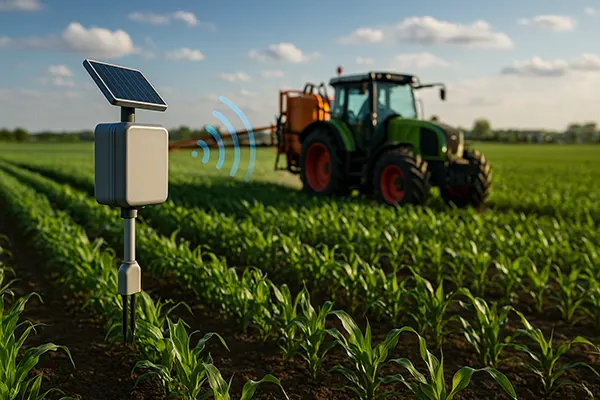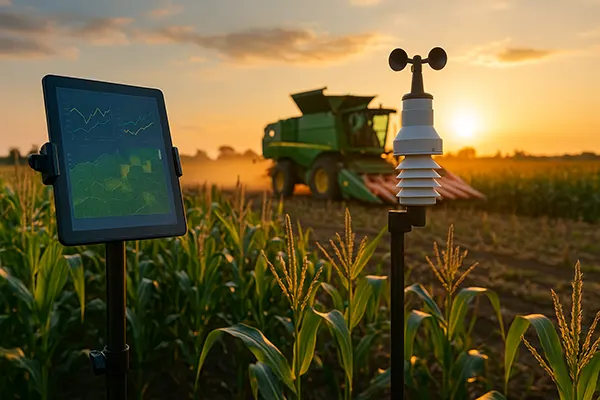
Internet of Things in Agriculture: The Future of AgriTech
The integration of Internet of Things (IoT) technologies in agriculture is transforming traditional farming into a highly data-driven and automated sector. This evolution is not only improving efficiency but also contributing to food security, sustainability, and environmental preservation. As of February 2025, the global agri-tech landscape is increasingly influenced by smart devices, sensors, and cloud-based analytics designed specifically for rural environments.
Precision Agriculture and Real-Time Data Collection
Precision agriculture is one of the most significant advancements enabled by IoT. Through interconnected sensors and devices, farmers can now collect real-time data on soil moisture, temperature, pH levels, and crop health. These metrics are essential in determining when and how much to irrigate, fertilise, or harvest, ensuring optimal crop yields with minimal resource waste.
One widely adopted solution is the use of soil moisture sensors connected to wireless networks. These sensors alert farmers via mobile apps when irrigation is required, preventing both under- and over-watering. Additionally, satellite imagery and drones equipped with NDVI (Normalized Difference Vegetation Index) sensors help monitor crop development, allowing for timely interventions.
By leveraging machine learning algorithms, these systems provide predictive analytics that enhance long-term agricultural planning. From pest outbreak forecasts to yield predictions, real-time data allows for highly informed decision-making across the entire farming cycle.
Cost Efficiency and Sustainability Gains
IoT adoption significantly reduces operational costs by automating manual tasks. Automated irrigation systems, for instance, operate based on sensor data without requiring human intervention. This leads to reduced labour costs and better water usage, which is particularly crucial in drought-prone regions.
Sustainability is another major benefit. IoT helps minimise the environmental impact of farming by precisely applying fertilisers and pesticides only where necessary. This reduces chemical runoff into nearby ecosystems and preserves soil health over time.
Moreover, energy-efficient IoT devices run on solar power or low-energy networks like LoRaWAN, making them ideal for remote rural areas without reliable electricity access. These technological adaptations support sustainable agriculture while reducing carbon footprints.
Livestock Monitoring and Smart Farm Management
IoT is not limited to crops—it plays a crucial role in livestock farming too. Wearable devices for cattle can track animal health indicators such as heart rate, temperature, and activity levels. Any anomalies can trigger alerts to veterinary teams, enabling rapid response to prevent disease outbreaks.
Furthermore, GPS-enabled collars allow farmers to track livestock locations in real-time. This is particularly valuable in open grazing systems, where the risk of animals straying or being stolen is high. Geofencing features even send notifications when animals leave designated areas.
Data from IoT-enabled milking systems also supports dairy operations by analysing milk yield, quality, and milking frequency. This promotes productivity and ensures compliance with regulatory standards regarding hygiene and animal welfare.
Remote Farm Surveillance and Security
IoT security solutions are becoming increasingly popular for farm surveillance. Smart cameras integrated with motion sensors can detect intrusions and send live footage to farmers’ smartphones. This reduces the risk of theft and protects valuable agricultural equipment and livestock.
In some cases, AI-powered systems can identify potential threats like wild animals entering farm premises, activating deterrents automatically. This proactive security approach enhances safety for both humans and animals.
Additionally, remote monitoring reduces the need for physical patrolling, which is both time-consuming and costly. With real-time surveillance data accessible from any location, farmers can manage security efficiently, even when offsite.

Challenges, Opportunities, and the Road Ahead
Despite its benefits, the widespread adoption of IoT in agriculture faces challenges. Connectivity in remote areas remains a critical issue. While low-bandwidth networks like NB-IoT and LoRa are mitigating this, complete coverage is still far from reality in many regions.
Another barrier is the cost of IoT infrastructure. While long-term savings are evident, the initial investment in sensors, gateways, and software can be prohibitive for smallholder farmers. Financial support and government incentives are needed to bridge this gap and encourage broader adoption.
Looking ahead, the development of edge computing and 5G networks will significantly improve IoT capabilities in agriculture. These technologies will allow for faster data processing and more complex AI applications on-site, further boosting efficiency and productivity.
Policy Framework and Education
For IoT to realise its full potential in agriculture, supportive policy frameworks must be implemented. Governments and international organisations should work together to standardise data sharing protocols, ensure cybersecurity, and promote ethical data use.
Education also plays a vital role. Farmers need training on how to install, use, and interpret IoT tools. Partnerships between universities, tech companies, and agricultural cooperatives can facilitate knowledge transfer and drive innovation from the ground up.
Ultimately, the success of IoT in agriculture depends on a holistic ecosystem that includes infrastructure, policy, training, and trust. With these components in place, the future of agri-tech is poised for extraordinary growth.